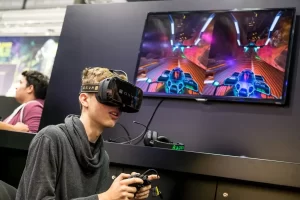
Tabletop gaming has come a long way over the years. From traditional board games to complex strategy games, enthusiasts have always sought out new ways to enhance their gaming experience. One of the latest innovations in the world of tabletop gaming is the integration of augmented reality (AR). This exciting technology has opened up a whole new realm of possibilities, creating immersive and interactive gameplay like never before.
What is Augmented Reality?
Before delving into how augmented reality is transforming tabletop games, it’s important to understand what exactly AR is. Augmented reality is a technology that overlays digital elements onto the real world, blending the virtual and physical environments seamlessly. Unlike virtual reality, which creates an entirely virtual world, AR enhances the real world by adding computer-generated graphics, sounds, and other sensory enhancements in real-time.
Revolutionizing Tabletop Gaming
The integration of augmented reality in tabletop games has revolutionized the way players engage with the game. It brings a new level of immersion by blurring the lines between the physical components and the digital elements. With AR, the tabletop becomes a gateway to a rich and dynamic gaming experience.
Enhanced Visuals
One of the most significant benefits of AR in tabletop games is the enhanced visuals it provides. Traditional games often rely on static images or illustrations on cards and boards. With AR, these visuals can be brought to life, adding animations, special effects, and 3D models. This not only makes the game more visually appealing but also helps players better understand the game mechanics and immerse themselves in the gameplay.
Interactive Gameplay
AR introduces a new level of interactivity to tabletop games. Players can physically interact with the game pieces and objects on the table while digital elements respond in real-time. This allows for dynamic gameplay mechanics, where the game adapts to the players’ actions. For example, in a fantasy-themed strategy game, players can cast spells by physically moving their hands over the game pieces, triggering visual effects and audio cues.
Dynamic Environments
AR enables tabletop games to create dynamic and ever-changing environments. Instead of a static game board, AR can project different terrains, weather conditions, or even time of day onto the tabletop. This not only adds a visual spectacle but also introduces new gameplay elements and challenges. For example, in a cooperative dungeon-crawling game, the AR system can generate randomized dungeons for each playthrough, ensuring that no two games are the same.
The Future of Tabletop Gaming
Augmented reality is still relatively new to the world of tabletop gaming, but its potential is immense. As technology continues to advance, we can expect to see even more exciting AR-enhanced games hitting the market in the future. Here’s a glimpse of what the future holds:
Multiplayer Experiences
AR opens up exciting possibilities for multiplayer experiences in tabletop gaming. Players can connect their devices and share the same augmented reality environment, allowing for cooperative or competitive play. Imagine battling against friends or working together to solve puzzles, all within the same virtual world projected onto your tabletop.
Expanded Game Libraries
With the integration of AR, game designers and developers can push the boundaries of traditional gameplay mechanics. They can introduce new genres, create innovative storytelling experiences, and explore game mechanics that were previously impossible. This will lead to an expanded library of tabletop games and provide players with a wider range of options to choose from.
Integrating Physical and Digital Components
In the future, we may see a seamless integration of physical and digital components in tabletop games. AR can bridge the gap between traditional board games and video games, offering the best of both worlds. Players could have physical game pieces interact with digital elements, allowing for new gameplay possibilities and experiences.
Conclusion
The integration of augmented reality in tabletop games has ushered in a new era of immersive and interactive gameplay. With enhanced visuals, interactive mechanics, and dynamic environments, AR is transforming tabletop gaming into a whole new experience. As technology continues to advance, we can only imagine the exciting possibilities that lie ahead for the future of tabletop gaming.


